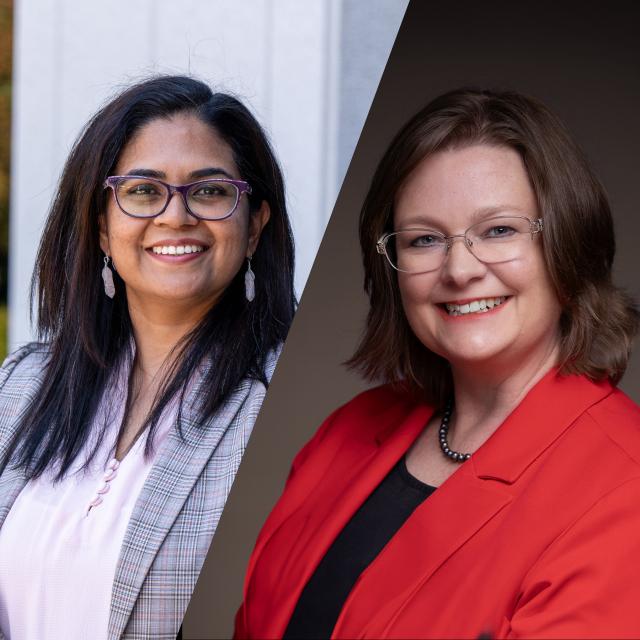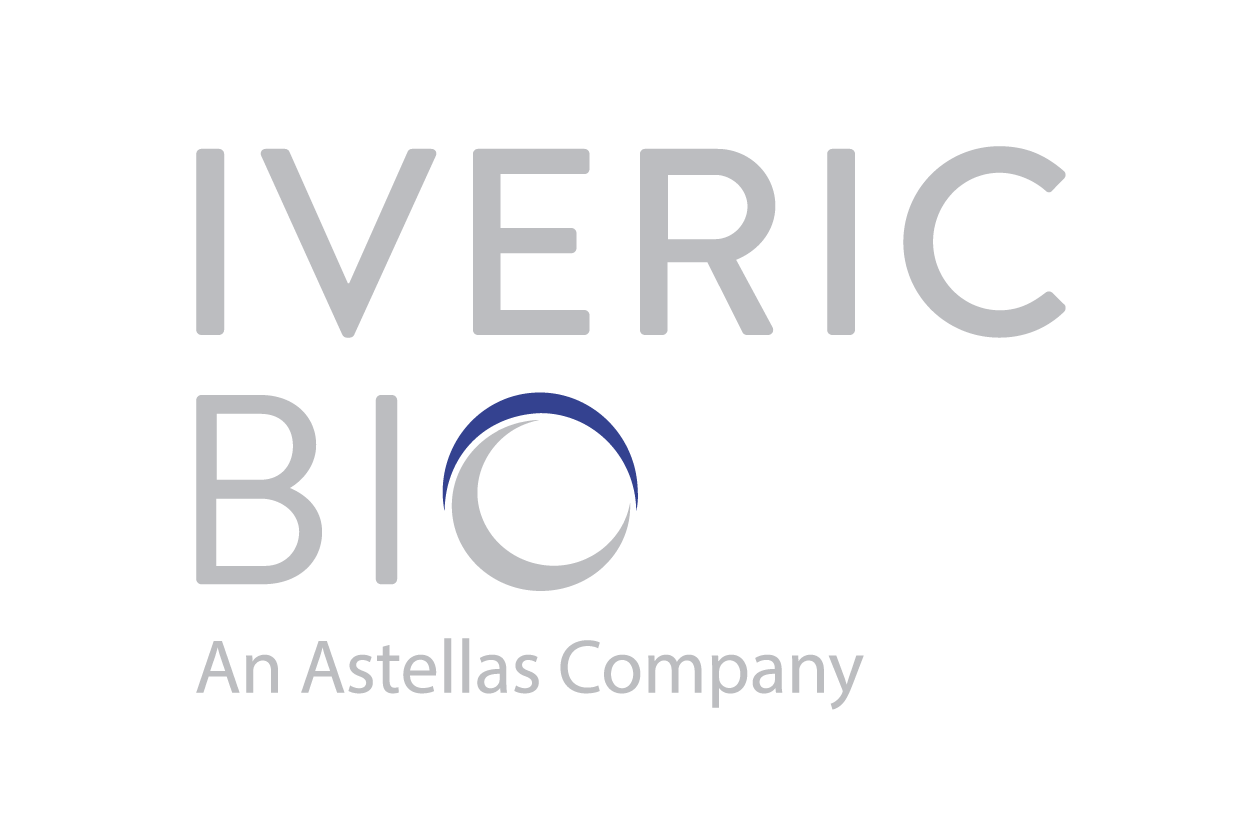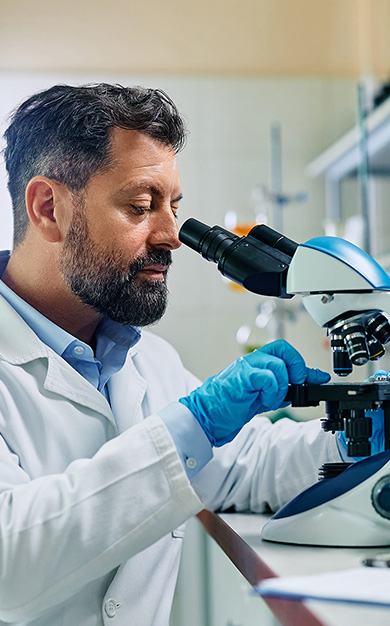Download English Transcript PDF
DR. DIANE BOVENKAMP: Hello and welcome. My name is Dr. Diane Bovenkamp, Vice President of Scientific Affairs at BrightFocus Foundation. I’m pleased to be your host for today’s Macular Chat that’s titled, “Promising Studies Funded by Macular Degeneration Research.” This Chat is brought to you today by BrightFocus Foundation. Macular Degeneration Research is one of our programs at BrightFocus. We fund exceptional scientific research worldwide to defeat Alzheimer’s disease, macular degeneration, and glaucoma, and we provide expert information on these heartbreaking diseases. You can find much more information on our website at www.BrightFocus.org.
I am so pleased to introduce my co-speaker and colleague, Dr. Preeti Subramanian. Dr. Subramanian is the Director of Vision Science Programs overseeing the macular degeneration and glaucoma research programs at BrightFocus Foundation. Dr. Subramanian, thank you for joining me today.
DR. PREETI SUBRAMANIAN: Thank you, Diane, for the introduction, and I’m delighted to be joining you today for the Chat.
DR. DIANE BOVENKAMP: Fantastic, and it’s just going to be so much fun today, so let’s get started. At the end of last month’s Macular Chat, I let the audience know that Macular Degeneration Research recently awarded 10 new research grants to exceptional vision scientists around the world, an investment of $2.8 million¾U.S. dollars. These are selected from a rigorous scientific process that BrightFocus has put in place to ensure that the most innovative science gets funded in a timely manner to move the field forward. Kudos to the phenomenal scientists who make up our scientific review committee, who gives us advice on what are the most innovative to fund and, especially, kudos to Dr. Subramanian for overseeing and guiding the program and support of this innovative research going forward. So, today, we are going to do something a bit different from our regular chats. Dr. Subramanian¾or I’m going to call her Preeti because I work with her every day¾and I have categorized the 10 new grants that were just funded a few months ago. We’ll divide them into three general research areas where we’ll highlight each of the innovative projects and scientists who proposed them to us. Near the end of our time together, we’ll address some of the questions that our listeners have sent in ahead of time. So, ultimately, everything that BrightFocus does is to move the field forward to benefit affected individuals and their families. And before we start, I want to specifically, and most importantly, thank all of our donors for supporting us in this goal. We couldn’t do what we do without you. So, Preeti, first off, would you give us a refresher of: What is age-related macular degeneration, or the abbreviation is AMD, and what are these dry and wet forms, terms that we hear about?
DR. PREETI SUBRAMANIAN: Sure, so age-related macular degeneration, or AMD as we call it, is the loss of the sharp, straight-ahead vision in the tiny bullseye at the back of the eye called macula. All forms of AMD start as the dry form of AMD at the very early stage. So, you see these tiny deposits—fatty deposits—that are also called drusen, and we’ll talk more about it later. The disease then progresses from intermediate to advanced form, and AREDS 2 is the nutrient formula that’s currently recommended to delay the progression from intermediate to advanced stages of AMD. In the advanced stage, there are two forms of AMD. There is the wet form of AMD where the blood vessels grow into the retina and cause blood leakage, leading to vision loss. There are anti-VEGF treatments that are available for this form of AMD. And then you have the other form, which is the advanced dry form of AMD, also called the geographic atrophy, where the retina cells that are responsible for detection of light are damaged and are lost, leading to vision loss. This past year, we saw approval of two new drugs for this form of advanced dry AMD. So, that summarizes the types of AMD that we have.
DR. DIANE BOVENKAMP: Yeah, and the fact that there’s two new drugs out there for dry AMD and there’s a full slew of drugs for wet forms, that’s so exciting. Though, some people could say, “Well, okay, we already have some drugs. Why do we need to learn more about the disease or create more drugs?”
DR. PREETI SUBRAMANIAN: Yeah, sure. So one main reason is that to create an effective treatment, one needs to understand the basics of the disease. And there’s still so much that we do not understand about AMD. And also there is a potential for combining the multiple drugs that are out there that target different aspects of AMD. And this is something that is commonly done in other disease forms, like cancer, for example, where you have combination therapy. So the more we learn about the disease, better treatments, more effective treatments that we can come up with.
DR. DIANE BOVENKAMP: Okay, great. That is a really good argument for all funding agencies to continue to fund what they call basic research. So, that’s why the first batch of grants … we’re going to have three categories here. So, the first batch of grants is in a category that we’re calling “Understanding AMD.” Humans get macular degeneration, but sometimes smaller animal species can be studied to better understand and treat the disease. So, we need models since, ethics-wise, there’s laws enforced by the U.S. Food and Drug Administration, or the FDA, to protect us. So, some could say, “Well, do you need to do wet lab experiments at all? You could just do computer modeling. We have AI.” But for many cases, this can help advanced knowledge. But using computer algorithms doesn’t necessarily work in a complex disease like AMD to fully understand the entire disease, especially when we don’t understand the disease. You get into this cyclic loop. So yeah, so that’s why it’s very important to still fund research to understand AMD.
DR. PREETI SUBRAMANIAN: Yeah. Absolutely. That is correct. And this will accelerate our understanding and coming up with newer treatments. So, using these small animal models is really a valuable tool. So, the first project that we’re going to talk about is that of Dr. Brittany Carr, who’s from the University of Alberta. And Dr. Carr has generated two models that mimic the human disease. So, these models have the drusen-like fatty deposit that we talked about earlier in the retina. And why is this important? It’s because a lot of models don’t have these deposits, so having models that mimic the human disease will enable us to monitor the disease from the beginning and devise ways for coming up with early interventions for the disease because now we can learn what is happening at the origin of the disease. And another advantage of using these small animal models is the ease it offers to answer some of the experimental questions that we have in the lab. And so, it’s really a very valuable tool to understand AMD from the beginning.
DR. DIANE BOVENKAMP: I’m really looking forward to the results of Dr. Carr’s project. I see that the next two projects on our list in this category of understanding AMD involves something called lipids. You’ve mentioned it a couple times before, but for our listeners, can you just describe what are lipids and how are they involved with AMD?
DR. PREETI SUBRAMANIAN: Sure. Lipids, or we can call them fats, these are part of the deposits that we see in AMD called drusen, which is important for initiation of dry AMD, which is one of the clinical features used for diagnosis. We know that these lipids form part of drusen, so it’s really important to understand how these lipids contribute toward formation of drusen. And one project that we are funding is that of Dr. Han from University of Michigan, where he’s trying to understand how these fatty deposits build up at the back of the eye and therapeutic ways that can be used to disrupt the formation of these fatty deposits using small-molecule drugs that could be a new treatment approach for AMD.
And another study that we’re funding is taking a different approach. Dr. Kushwah from Boston Children’s Hospital, she’s looking at linking lipids with the immune system, and the immune system is also known to play a role in AMD. So, looking at how these fatty deposits happen in the pigment epithelium cells at the back of the eye, the immune cells, and how they crosstalk with inflammation, which is another important factor in AMD, particularly if there is excess of inflammation that can cause an imbalance and trigger the initial phase of AMD. So, the point is that these approaches that are being studied can come up with early interventions that can prevent the downstream damage that can happen due to aggregation or formation of all these fatty deposits that might be a precursor to trigger the disease.
DR. DIANE BOVENKAMP: All right, so these drugs, when they’re ultimately created, they’ll come in before the drugs that are currently on the market, so that would be so amazing to catch the disease before serious damage is done, and maybe people might have AMD, but you haven’t lost any ability to see photos, read books, etc. That would be awesome. So, the last set of two projects in this first section are on something called oxidative stress and inflammation. And so, could you just go over what are those and why are they important for AMD?
DR. PREETI SUBRAMANIAN: Yeah, I am glad you asked, because oxidative stress is another contributor to AMD, constant exposure to light, and other stressors, like cigarette smoke. Smoking is a major modifiable risk factor for AMD, along with aging. So, understanding how these stressors contribute to AMD, identifying different pathways¾biological pathways¾that are involved that we can later use to protect the eyes from the damage caused by these stressors is an important area of research. So, scientists like Dr. Singh at Johns Hopkins is trying to create a smoking model to mimic these stress conditions and screen for targets that can be used for feature therapies.
DR. DIANE BOVENKAMP: So, let me just interject in here with a public service announcement for our listeners. The number one thing to do to reduce the risk of development or progression of AMD is to stop smoking now. And also, you referred earlier about light damage. A second wise thing to do would be to protect your eyes from the lights, so wear sunglasses and a wide-brimmed hat. So, even if you have genetic inheritance or the presence of AMD in other members of your family, you might never develop the disease if you take care of yourself and protect yourself. I just wanted to do that PSA. Sorry, we can get back to our regularly scheduled science now, Preeti.
DR. PREETI SUBRAMANIAN: Absolutely. No, that’s great. So, the last project in this category is that of Dr. Subrahmanian—no relation; we just share the same last name. Dr. Subrahmanian is studying a novel molecular switch that plays a role in the failed antioxidant and inflammatory responses in these cells in the eye. And so, the eye has a natural antioxidant mechanism, which just stops working with aging. So, in a way, this project studies the earliest event that sets off excess of inflammation. So, again, we’ll get more insight into potential therapeutic targets for early intervention at the beginning of the disease.
DR. DIANE BOVENKAMP: Aha! So, this is like a situation like encountered, if I may digress into a pop culture reference, a fairy tale character, Goldilocks and the three bears, where having too little inflammation can lead to illnesses taking over since your defenses are down and don’t protect yourself from bacteria and viruses, but too much inflammation can cause damage and disease, like AMD. So, we need to have just the right amount of inflammation to stay healthy.
DR. PREETI SUBRAMANIAN: Right. Absolutely. To wrap up this session, we talked about how it’s important to have good models to study AMD. It enables us to identify early indicators, to learn about the fatty deposits that are part of drusen, and also enables us to understand the complex balance of inflammation. And all this can help us to better understand AMD and come up with better strategy to defeat the disease.
DR. DIANE BOVENKAMP: Excellent. That was a great summary. So, we discussed half of the 10 projects already in that first category. The next section, the second out of three sections, we’re calling “Early Detection.” There are two projects studying different ways of early detection of disease. So, Preeti, why is it important to have early detection?
DR. PREETI SUBRAMANIAN: Yes, I want to start with an announcement here to get regular eye checkups because there are no early indicators of some of the eye diseases. And particularly in AMD—half of the people who have AMD don’t know they have it. So, the only way to know is if we go in for a dilated comprehensive eye exam for prescreening. And the National Eye Institute recommendation is to have an annual, or at least, like, an eye exam, every 2 years after the age of 40.
DR. DIANE BOVENKAMP: Absolutely, so it’s like needing to detect it earlier because time lost is vision lost, right?
DR. PREETI SUBRAMANIAN: Yeah, yeah. And also, some of the common vision tests, the types of research that we are funding in this section, there are some common tests that do not detect vision loss very early on in the disease. And so, this project that we are funding—Dr. Pfau. He’s working on creating vision tests that will help measure how well our eyes adjust to the darkness after being exposed to bright light. And so, he will be able to examine, with a high degree of accuracy, small areas in the retina in the eye that may be prone or more sensitive to these small changes. And this will allow for early measurement of how the disease is progressing, and it can be a very valuable tool for prescreening of the disease very early on.
And another study that we are funding in this category is Dr. Bellver at University of Colorado, where he is looking at tiny particles that are secreted naturally by the eye, particularly the retinal pigment epithelial cells that are located at the back of the eye. And these particles can have signatures, or we can call them fingerprints, for early indicators of the disease. And so, we’re trying to understand what’s in those tiny cargo sacks to see if there are candidates that can be used for early detection of the disease. That could be a very valuable tool for diagnosing early on or detection of the disease early on.
DR. DIANE BOVENKAMP: Wow, that would be really great to have an earlier one or two or more ways to detect earlier and earlier before a disease even starts. Yeah, so I’m really looking forward to following the results of these two projects, too. So, I guess the last category would be the third category, we’ve lumped together in what we’re calling treatments. So, these three projects that are in this current fiscal funding year are more late-stage treatment options, the potential to restore vision after much damage has been done. The first type, I think, involves some kind of regeneration. Can you tell us more about those projects?
DR. PREETI SUBRAMANIAN: Yeah, sure. There are species that are known to regenerate, which is something that the human eye can’t naturally do. So, they provide a unique opportunity by studying these species to understand the mechanism by which they are able to do that. Dr. Kroeger, who’s at University of Georgia, is using a species called the brown anole lizard that has the ability to regenerate the color-detecting cone photoreceptors, which are lost in AMD. So, understanding how the species is able to regenerate these cone photoreceptors, Dr. Kroeger will come up with new strategy to regenerate our own photoreceptor cells in the eye. So, that’s a real cool way to understand and learn from other species how we can improve our system.
And the other project is Dr. Wohlschlegel from University of Washington, and she’s trying to regenerate some of the support cells in our eye, which are called the glial cells, and how they can be converted into the light-detecting cells, particularly the cone photoreceptors that we talked about in the earlier project. And that way, the cells that are lost in AMD can be replenished in the eye. Even though it may be in an advanced stage of the disease that the cells are lost, this could help us to come up with strategy that may enable to restore vision loss at a late stage.
DR. DIANE BOVENKAMP: Wow, that is so cool, to be able to regenerate vision in our own eye. It almost sounds like a science fiction movie. But yeah, we’re getting closer and closer every day to making that a reality. And I think it would really give hope to those who have lost vision beyond the help of current treatments, right?
DR. PREETI SUBRAMANIAN: Yeah, absolutely. I think there are some really innovative approaches that are coming up, and that’s really exciting. That gives a lot of hope for the future. And the last topic that we have is something that’s called the transplant-independent therapy. As we discussed earlier, aging is one of the risk factors for AMD, and in this particular study Dr. Shirahama is using an approach to reverse aging in cells affected by AMD. And he’s trying to make the cells go back in time to their younger self by using factors that are already tested and shown in other disease models to restore vision loss. So, if Dr. Shirahama can reverse the age of the retinal pigment epithelial cells¾the RPE cells¾that are damaged and are involved in AMD, then these younger cells could successfully combat the disease and possibly restore the vision loss. So, this is another cool study that can be very beneficial at a later stage in the disease to combat vision loss.
DR. DIANE BOVENKAMP: This is another really cool project. I mean, reversing the age of cells sounds like something like Spanish conquistador Juan Ponce de Leon was looking for in the 1400s with the Fountain of Youth. That blows your mind, so I’ll definitely be interested in following this project, too. So, thank you so much, Preeti¾Dr. Subramanian¾for explaining these 10 newly funded projects. They cover, as you can—well, you’ve listened to in the last half hour, I guess, we’ve been talking—that they cover a diverse number of topics underlying our mission of investigator-initiated research. And so, it really shows that we have a diverse portfolio to tackle macular degeneration from all sides. So, this is the point in our plan for the talk that we wanted to address a couple of pre-call, listener-submitted questions. There was one interesting question that came in, Preeti, and a number of people asked about this: Is there any update on the red light therapy for macular degeneration?
DR. PREETI SUBRAMANIAN: Yeah, so there have been some clinical trials that have been conducted to evaluate if red light therapy can slow the progression of AMD. And the data is mostly inconclusive on whether it offers any benefit to AMD, so I would caution our listeners to avoid using any red light therapy that’s commercially available for the eye, as these are not approved by FDA for treatment of AMD.
DR. DIANE BOVENKAMP: Very important. Very important, because you never know … you know, look on social media or wherever you find information these days, and you always want to check with a reputable source, of course, that it’s—before you use it on your body or that of a loved one—that it’s been approved by the FDA or another reputable source. So, thank you for telling us about that.
So, another question that we have here is: What are the advances in stem cell treatment for macular degeneration, and will it be safely offered in other countries first? So, instead of going over and summarizing all this again, basically, nothing has approved yet for stem cell treatments, but they are in clinical trials, stay tuned. But I highly recommend, and this is a little self-reference here, to go back and listen to two of our past Macular Chats. So, one I recommend the listeners revisit, and you can go online or wherever you get these. I think there’s a number of different media¾streaming, YouTube, etc.¾that you can get these podcasts. In November 2023, I had an interview with Dr. Kapil Bharti from the National Eye Institute. It’s called, “Can Vision Loss Be Reversed: Stem Cells and AMD.” So, that one is the most recent one, and then there’s another one. In October 2022, there’s an interview with Drs. Sally Temple and Jeffrey Stern, who were talking about an ongoing clinical trial of adult stem cell treatment targeting AMD. So, please go back. The information in that is, because clinical trials take time, it’s probably still relevant today.
Okay. Yeah, so I guess it’s a quick call today, half an hour. Preeti, as our time together draws to a close, do you have any further thoughts on BrightFocus’ funding in macular degeneration research?
DR. PREETI SUBRAMANIAN: Yeah. Our program—our Macular Degeneration Research program—we take a comprehensive 360-degree approach to funding innovative scientific research worldwide, exploring the full range of scientific paths to develop better treatments and, ultimately, find a cure. So, Diane, as you mentioned before, we have a diverse range of topics that we discussed today, and these studies lay the groundwork for potential future therapy for macular degeneration.
DR. DIANE BOVENKAMP: Great. And I just have to emphasize again, thank you so much to our donors for supporting us to be able to support this innovative research. So, Dr. Preeti Subramanian, this was so wonderful to have a live discussion with you about the exciting and promising research and the latest round of funded macular degeneration research. To our listeners, I sincerely hope you found today’s Chat helpful.
Our next Macular Chat will be on Wednesday, September 25, and it’s titled, “Understanding Stargardt Disease,” Stargardt disease being a juvenile form of macular degeneration. Thank you again to our listeners for joining us today. This concludes today’s Macular Chat.









